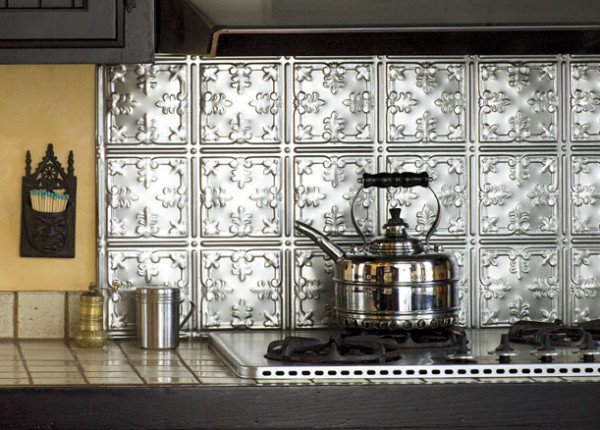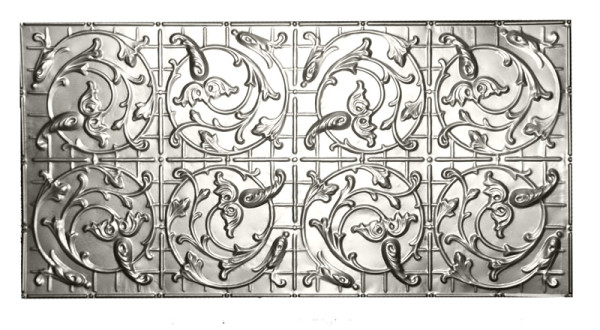
Varnished metal ceiling panels became the range backsplash in a Victorian house. (Photo: Duncan Livingston)
The cost is relatively inexpensive and it’s a DIY project. “We’ve sold our metal for a bazillion backsplashes over the years,” says Mark Quitno of W.F. Norman, a Missouri company founded in 1898. “We can stamp panels out of galvanized steel by special order,” Quitno says, “but 99% of customers buy the standard tinplate metal, even for wet areas. You just have to install it and finish in properly.”
APPLICATION Wipe the metal with lacquer thinner before priming both sides with a Rust-Oleum-type product, all before installing the panels—it’s cheap insurance against rust in a high-humidity room. The panels can be attached to plywood sheathing or wood furring strips. But for retrofitting the metal surface to plaster or existing tile, many people use a compatible construction adhesive. The substrate must be completely cleaned and degreased. Just nailing the metal to plaster or drywall is not secure enough and allows moisture to get in.
The metal edges are very sharp. Wear heavy work gloves and use eye protection when snipping. Raw edges may be tapped in and sealed with silicone caulk, or you can trim out the panels in a narrow moulding or quarter-round. Do use silicone caulk on edges near sinks and stoves and where the backsplash meets the countertop. Paint the moulding the same color as trim, or stain it to match surrounding woodwork.
At corners, flat patterns can be bent at 90 degrees. If the embossing is deep, carefully butt edges, then caulk and paint. “Some customers have used wooden corner trim on outside corners,” Quitno says.

Scaled for a larger wall surface, the #213 ceiling design from W.F. Norman comes in 24 x 48 inch panels.
FINISHING To maintain the natural tin color, clear-coat with oil-based polyurethane. A satin finish looks hand-rubbed, while high gloss may look like plastic. For a painted finish, any high-quality oil enamel, flat to glossy, will look good and be durable and washable. Do not use water-based (latex) finishes on metal ceiling panels. To clean the backsplash, just wipe it down with a mild soap solution and soft brush, sponge, or cloth.
PATTERN CHOICE
In greasy areas, a flatter pattern is recommended over hard-to-clean deep embossing. Think about scale and proportion; for most backsplashes, a 6″ repeat is best (the sheets are generally 2′ x 4′). Center the pattern in the most visible place and account for waste when ordering. Outlet holes are easy to cut out with tin snips, or you can chisel them out after panels are installed. (Cut the electricity.)







